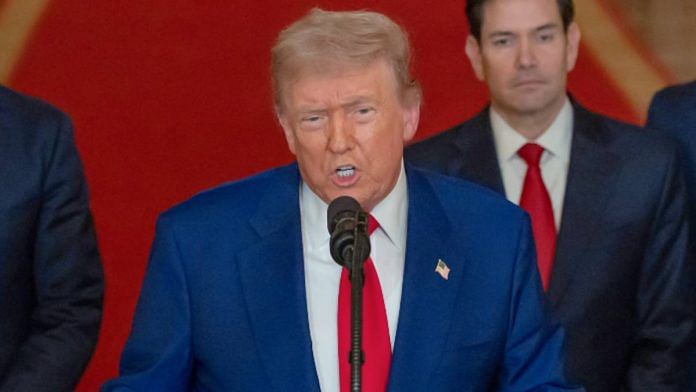Thank you dear subscribers, we are overwhelmed with your response.
Your Turn is a unique section from ThePrint featuring points of view from its subscribers. If you are a subscriber, have a point of view, please send it to us. If not, do subscribe here: https://theprint.in/subscribe/
The global trading order is once again on edge. US President Donald Trump has unveiled what many call the most sweeping tariff escalation in nearly a century—threatening fragile supply chains, destabilizing emerging markets, and imposing unseen costs on American consumers themselves. Steep duties ranging from 25% to 40% have been slapped on countries across Asia and Africa—Bangladesh, Cambodia, Indonesia, Myanmar, Laos, and others. The justification? A muscular return to the doctrine of “reciprocal trade.”
But can a world interwoven with global supply chains afford to view trade as a tit-for-tat exercise in bilateral accounting?
The Mirage of Reciprocity
On paper, reciprocity may seem fair. Why should the US offer low or zero tariffs to countries that impose steep barriers on American exports?
But this logic crumbles under scrutiny. Trade isn’t a seesaw of exports and imports—it’s a complex web of comparative advantage. Many of these targeted nations are manufacturing hubs in global value chains. Garments from Bangladesh, microchips from Malaysia, or auto parts from Thailand are not isolated “foreign” goods—they are integral components of larger multinational production systems.
Mechanical reciprocity disregards the economic reality of developing nations, many of which rely on exports to power growth, generate employment, and stabilize their fragile economies. Treating trade imbalances as proof of foul play is an outdated metric in an interconnected world.
Supply Chains Under Siege
Global supply chains are not easily re-engineered. Corporations have spent decades building cost-effective production corridors across Southeast Asia. Trump’s tariff shock introduces uncertainty and inflation that these businesses cannot easily absorb.
Bangladesh’s garment sector, for instance, now faces a 35% tariff wall. Cambodia and Thailand are slapped with 36%, while Myanmar and Laos are hit with an astonishing 40%. These are not frictions—they are chokeholds. The consequences could be severe: cancelled orders, manufacturing shifts, job losses, and rising input costs for US-based firms.
Such tariffs could ultimately force companies to offshore further to avoid exposure—ironically deepening the very trade deficits Trump seeks to reverse.
American Consumers: The Unwitting Collateral
Tariffs are, in essence, taxes paid not by exporting nations, but by importers—and ultimately, consumers. Trump’s strategy will raise prices on clothing, electronics, and household goods for American families.
The S&P 500 has already reflected this anxiety, falling 0.8% in a single day—its worst in weeks. These tremors hint at broader volatility, particularly if the tariffs stay on course after the August 1 deadline.
Strategic or Symbolic?
So what is the raison d’être behind this tariff blitz?
Beyond campaign trail optics and populist appeal, there appears to be a deeper geopolitical calculation. Many of the countries hardest hit by the tariffs are recipients of Chinese investment or linked to Beijing’s Belt and Road Initiative. By targeting their exports, Trump may be attempting to weaken China’s regional clout and fracture its economic alliances in Asia.
This is less about balancing trade—and more about tilting power.
Global Signals and the Rules-Based Order
Washington’s move sends an unambiguous signal: bilateralism is back, and it’s brutal. Multilateralism, the cornerstone of post-war trade, is being side-lined in favour of deal-making by coercion.
Of the 90 deals Trump had hoped to strike in 90 days, only two have materialized—one with the UK and another with Vietnam. Others, including India, the EU, and South Korea, are racing against time. The message is clear: deal on Trump’s terms, or brace for tariffs.
India, too, must navigate this terrain carefully. While US officials have expressed optimism about a breakthrough, the shifting sands of American trade policy demand realism and strategic agility—not mere compliance.
What Next?
More countries are expected to receive warnings in the days ahead. And Trump’s threat to penalize goods rerouted via third countries could trigger ripple effects far beyond Asia. Even allies like Japan and South Korea haven’t been spared—both now face steep tariffs despite longstanding security and trade partnerships.
The risk is that this approach—if copied by other nations—could unravel the very fabric of global trade. What begins as a doctrine of reciprocity could spiral into a chain reaction of retaliation.
A Turning Point for Trade?
We may be witnessing a shift from rules-based global trade to a transactional, unpredictable future. The consequences won’t just be felt in trade data—they’ll manifest in lost jobs, pricier goods, and geopolitical fragmentation.
Trump’s strategy may deliver political wins. But whether it delivers economic gain—for the US or the world—is far from certain.
Mohan Murti
Advocate & International Industry Arbitrator
Former Managing Director-Europe
Reliance Industries Ltd, Germany
Member of Supervisory Board
Innoplexus AG, Germany
These pieces are being published as they have been received – they have not been edited/fact-checked by ThePrint.


